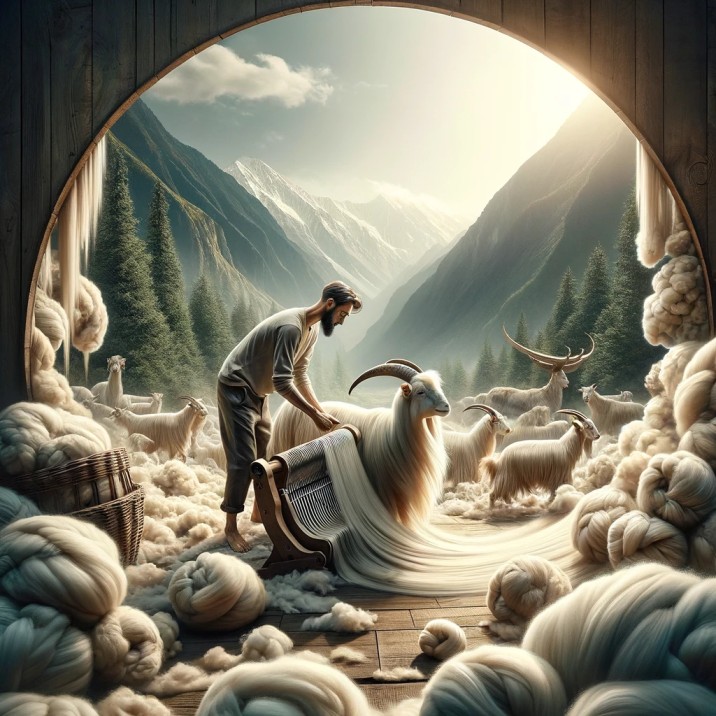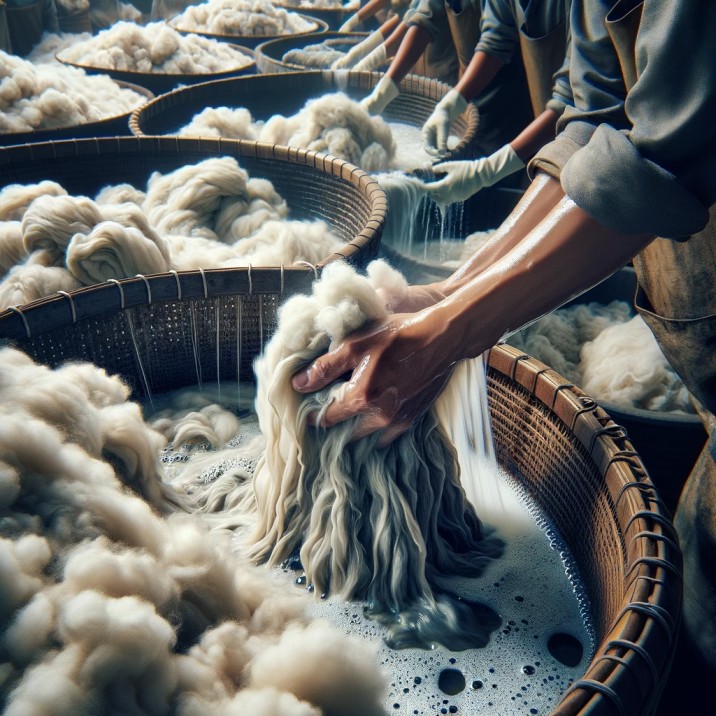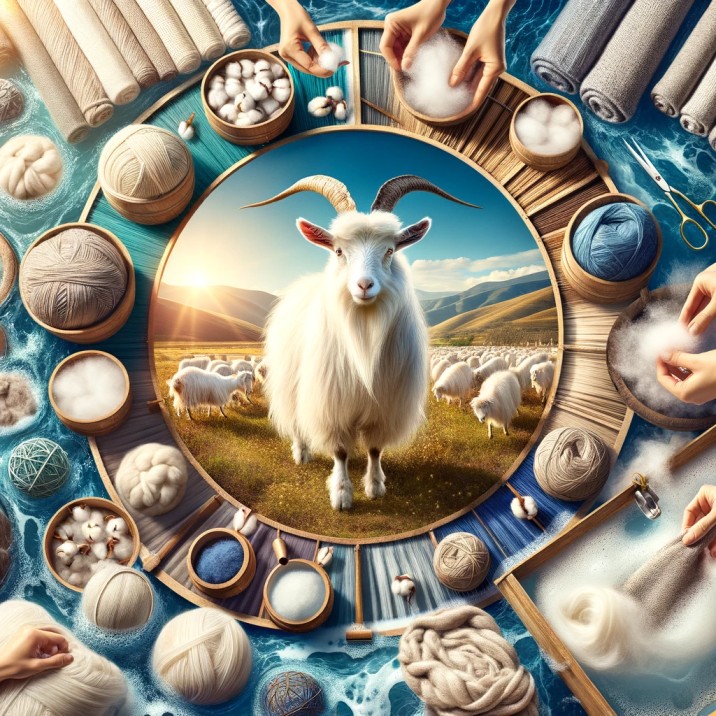The short answer for How is cashmere made? Cashmere is made from the soft undercoat of cashmere goats. The process involves collecting the goats’ shedding undercoat, spinning the fibers into yarn, and then weaving or knitting the yarn into cashmere products.
Cashmere, known for its softness, warmth, and luxurious feel, has long been a prized material in the fashion world. This coveted fabric is not made from sheep’s wool but from the undercoat of cashmere goats. The journey from these goats to the sumptuous sweaters and scarves in high-end boutiques is a fascinating tale of tradition, craftsmanship, and meticulous labor.
Origins of Cashmere
The origins of cashmere trace back several thousand years to the mountainous regions of Kashmir, located between India, Pakistan, and China. This area, known for its harsh and frigid climate, is the natural habitat of the Capra Hircus goat, from which cashmere wool is sourced. These goats have adapted to the extreme weather conditions by developing an exceptionally warm and soft undercoat.
The use of cashmere wool in garments dates back to the 3rd century BC, but it was not until the 15th century that Kashmiri craftsmen were noted for their intricate shawls made from this material. These shawls became highly coveted items, especially during the Mughal Empire, where they were prized for their softness and warmth. The Mughal emperors’ patronage of cashmere products played a significant role in the proliferation of the craftsmanship and artistry associated with cashmere.
By the 16th century, the fame of Kashmiri shawls had spread to Europe, thanks to the Silk Road. They became symbols of elegance and status among European aristocracy, particularly in France and England. The term “cashmere” began to be used in the 19th century, derived from an anglicized version of “Kashmir,” reflecting the region’s deep association with the fine wool.
The Industrial Revolution and advancements in textile manufacturing in Europe led to an increased demand for cashmere. Scottish textile mills, in particular, became centers for cashmere production, where they replicated and modified the traditional Kashmiri techniques. This marked the beginning of cashmere becoming a globally sought-after commodity, no longer confined to the high mountains of Kashmir but appreciated worldwide for its unparalleled softness and warmth.
Collection of Cashmere Fibers

The collection of cashmere fibers is a delicate and time-consuming process, usually carried out in the spring when cashmere goats naturally shed their winter coats. This crucial step involves either combing or shearing the goats. Combing is preferred as it yields longer, finer fibers and is less stressful for the animals. The undercoat, which is soft and downy, is gently separated from the coarser outer coat. This task requires skilled hands, as it’s vital to collect the fibers without harming the goats. The resulting raw cashmere is a blend of softness and warmth, ready for the next stages of cleaning and processing.
Sorting and Cleaning

The sorting and cleaning phase in cashmere production is a critical and labor-intensive process, essential for ensuring the superior quality of the final cashmere products. After the raw fibers are collected from the goats, they undergo a meticulous sorting procedure. This is traditionally done by hand, where experienced workers carefully differentiate the soft, fine undercoat fibers from the coarser outer hairs. This separation is crucial because the softness and luxurious feel of cashmere are attributed to the fineness of these undercoat fibers.
The cleaning phase follows sorting. The raw cashmere, still containing natural oils, dirt, and debris from the animal’s environment, must be thoroughly but gently cleaned to maintain the integrity of the fibers. This process involves soaking the cashmere in a series of lukewarm water baths with mild detergents. The aim is to remove impurities without damaging or felting the delicate fibers. Skilled workers ensure that the washing is thorough yet gentle, preserving the fibers’ natural softness and preparing them for the next stages of production, such as dyeing and spinning.
Throughout the sorting and cleaning stages, great care is taken to maintain the quality and integrity of the cashmere. The workers’ expertise and the traditional methods used are as important as the raw materials themselves, contributing significantly to the luxurious quality of cashmere products. This phase of production, while time-consuming, underscores the value and uniqueness of cashmere, setting it apart from other materials in the textile industry.
Spinning the Cashmere
The cleaned cashmere is then spun into yarn. The spinning process can be done either by hand or with a machine, but either way, it requires great skill to maintain the delicate balance between the fiber’s softness and strength. The quality of cashmere yarn depends largely on the length and fineness of the fibers.
Dyeing and Weaving
The cashmere yarn can be dyed in a range of colors. Once dyed, it is woven or knitted into various products. Weaving is generally used for producing cashmere fabrics for coats and suits, while knitting is used for making sweaters, scarves, and hats.
The Final Product

The final stage in cashmere production transforms the delicate fibers into luxurious garments. After spinning, dyeing, and weaving or knitting, the cashmere takes form as elegant scarves, cozy sweaters, or plush blankets. Each piece undergoes a rigorous finishing process which may include washing, drying, and ironing to enhance its softness and luster. Some items receive final touches like trimming or the addition of decorative elements. The culmination of this intricate process is a high-quality, durable product that embodies comfort and sophistication. The allure of cashmere lies in its exquisite texture, warmth, and the skilled artisanry behind every piece, making it a timeless and cherished addition to any wardrobe.
The creation of cashmere is a blend of traditional methods and modern techniques. Its production is a labor-intensive process that requires skill and precision at every step. The result is a material that is not only treasured for its warmth and softness but also admired as a symbol of luxury and elegance. As consumers become more environmentally conscious and ethically aware, the cashmere industry is adapting to ensure that this luxurious fabric can be enjoyed responsibly for generations to come.

